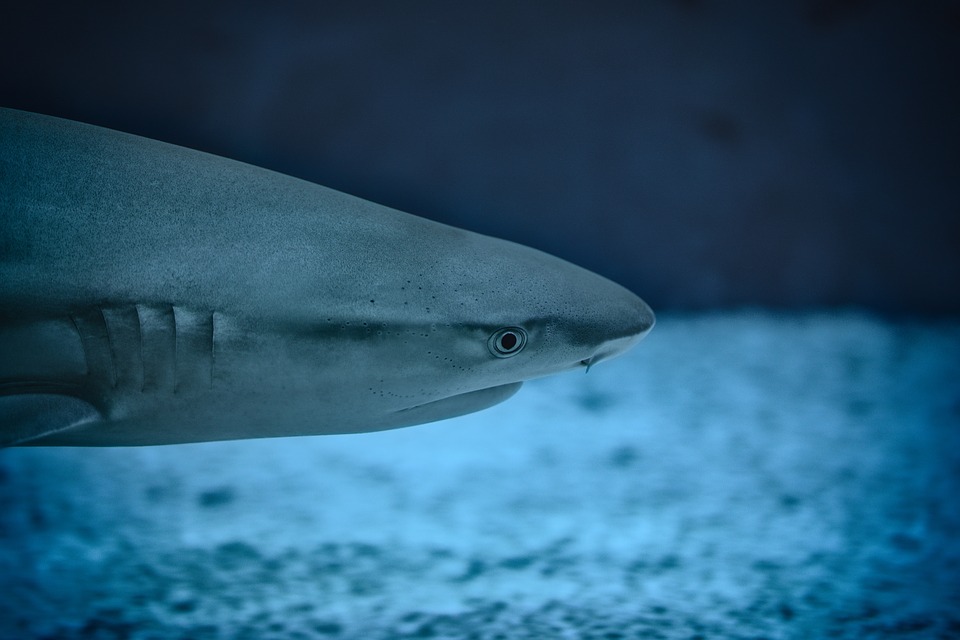All About Sharks
There’s more to these fascinating and endangered creatures than their one-dimensional portrayal as mindless movie predators.
Sharks belong to the group of fish known as elasmobranchii. This means that their skeleton is made of cartilage instead of bone. The earliest sharks appeared in the fossil record around 420 million years ago but the first modern sharks did not appear until 100 million years ago, around the time of the dinosaurs. The cartilage skeleton of sharks is not a primitive trait; sharks evolved from fi sh that did have bones. It is possible that the lighter, more flexible cartilage skeleton may have evolved to make sharks faster and agiler but it may also have been a way to conserve the amount of phosphorus needed by the shark metabolism. Sharks need phosphorus for their teeth and because sharks continually shed and replace teeth, they can get through more than 30,000 in their life. The availability of mineral phosphorus to make new teeth is one of the primary constraints for the spread of shark species around the world. In the 19th Century, sharks were generally regarded as entirely benign to humans. Though reports of shipwrecked sailors being attacked had been around since 1580, they were dismissed as exaggerated or mistaken. In 1891, millionaire Hermann Oelrichs offered a $500 reward for an authenticated case of a shark attack on a human off America’s east coast. This went unclaimed. Then in 1916, a spate of widely publicised shark attacks marked the start of a complete reversal in the image of the shark. After almost a century of bad press, sharks are only just starting to be properly understood.

Physical characteristics
Sharks range in size from 30cm to over 12 metres long and can weigh up to 20 tons. Their skeleton doesn’t include ribs so without the water to support them, the weight of their own bodies would crush their internal organs. Sharks don’t have a swim bladder either so they generate buoyancy using squalene oil stored in the liver. Because they can’t quickly change the amount of squalene in their body, sharks can’t maintain neutral buoyancy at rest. Instead, they tune their buoyancy so they are slightly denser than the surrounding water. Many species of shark have capitalised on this to become bottom dwellers and the pelagic (open sea) species make up the difference in buoyancy with dynamic lift generated by the flow of water over their fi ns as they swim. Most sharks live in waters no deeper than 2,000 metres. Although sharks don’t have true bones, areas of the body subject to the largest mechanical stress are reinforced with a hexagonal grid of crystalline calcium salts. Large sharks such as the great white may have several layers of this reinforcement. Shark skin is much tougher than that of other fish. The base layers are a helical mesh of collagen fibres, like the sheath on a rope and this is covered with a layer of tiny scales, called dermal denticles. Each denticle is made from dentine, which is another calcium-impregnated tissue. Dentine is a major component of teeth and in fact, it is likely that the teeth of vertebrates evolved from these denticles, so a shark is actually covered from nose to tail in a coat of teeth! As well as providing protection, the denticles act in a similar way to the dimples on a golf ball. By generating tiny vortices at their trailing edges, they reduce drag and allow sharks to swim more efficiently. Sharks have only average eyesight but extremely acute hearing and smell. Like most other fi sh, they also have a strip of vibration-sensitive hair cells, running the length of their body. This is called the lateral line and is used to detect the movement of prey. In sharks, these cells also run in a complex pattern around the head, which makes their vibration sense much more directional. And sharks have yet another sense: electroreception. The Ampullae of Lorenzini are modified lateral line cells that can sense the weak electric fields produced by all living things. A few other fish have an electroreceptive sense but the sharks are by far the most sensitive. As well as finding prey at night, sharks can use the electric field generated by ocean currents moving within the Earth’s magnetic fi eld as an internal compass.
Shark Attacks
Two tons and up to 3,000 teeth? That’s going to hurt…
Shark attacks are recorded worldwide by the International Shark Attack File, which was set up in 1958 by the US Office of Naval Research. It has data on over 4,000 incidents, going back to the 16th Century. Shark attacks on humans peaked in 2000 with 79 attacks worldwide, of which just 11 were fatal. Since then attacks have been steadily dropping and the number of fatalities is now less than five per year worldwide. Most of these occur in the USA, probably because of the high overlap of surfing beaches with shark territories. This compares with over 3,300 Americans who drown each year.
Only four species of shark are responsible for fatal, unprovoked attacks on humans: the great white, tiger, bull and oceanic whitetip shark. The oceanic whitetip almost never comes close to the shore and all of its attacks on humans have been on shipwrecks and plane crash survivors. Sharks do not generally attack humans to eat them. Bites are either exploratory, where the shark isn’t sure what to make of a wetsuit-clad surfer, or they may be because the shark is defending a territory. Even when a shark is intending to kill, it will generally bite once and then retreat, while it waits for you to die from blood loss. This often gives swimmers time to reach shore or a boat and survive.
How to survive a shark attack
When you hear that ominous cello music, here’s what to do.
A reassuring 80 per cent of shark attack victims survive. Mostly this is because the shark loses interest but there are cases of people successfully fighting off a shark. Some studies have shown that just touching a shark on the snout can cause it to halt in mid strike, but the International Shark Attack File advises hitting the nose as hard as you can. Don’t use your fi sts or feet unless you have no other weapons to hand – it’s too easy to get them bitten off. Grabbing for the eyes is unlikely to work. They are a very small target and great whites will roll their eyes back in their sockets for protection right before they strike anyway. The gill slits are a more promising target; the gills inside are both delicate and sensitive. Don’t play dead, sharks are more likely to bite you if you look defenceless. Equally though, too much splashing and noise will act to attract sharks. If you manage to drive the shark away, don’t relax just yet. Sharks are very curious and this one will be back soon. Get out of the water straight away if possible. If you are diving in open water, come to the surface, swimming back-to-back with your diving buddy.
How sharks reproduce
Like many top carnivores, sharks take good care of their young. Rather than producing huge numbers of eggs, each with very little chance of survival, sharks produce between two and 100 young at a time. This is much lower than most fi sh. Fertilisation is internal with the male using a pair of organs called claspers in much the same way as a penis. Some of the smaller shark species, such as the horn shark and the cat shark, lay eggs, which are protected within a leathery egg case and often wedged into crevices. Most sharks retain the eggs in the female body though. This is called ovoviviparity and it is different from the live birth or viviparity found in mammals because all the nourishment for the embryo comes from the yolk of the egg. Only in a few species, including the hammerhead and tiger shark, are the embryos fed with a placenta connected to the mother. In many species, the first shark to hatch will eat any remaining eggs in the oviduct as its first meal and newly hatched grey nurse shark will even eat the other developing embryos. Sharks have very long gestation periods – as long as 24 months for some species.
Sharks in Danger
What are the threats to sharks worldwide?
A hundred million sharks a year are killed by humans for food. Because sharks reproduce slowly and take a long time to reach adulthood, most fishing stocks are in steep decline. Studies have shown population declines of 70-90 per cent for the commercially fished species in the last 30 years. As well as for their meat, sharks are fished for their fins to meet the massive demand for shark’s fin soup in Asia. Often these are removed using a hot knife and then the shark is thrown back but unable to move, or they quickly die anyway. Shark cartilage is also used to make alternative medicines due to the belief that it can cure or prevent cancer. There is no scientific evidence to support this idea. Sharks are also threatened to some extent by coastal development, marine pollution and over fishing of their own prey, as well as sport fishing. But all of these are much less signifi cant than the effect of commercial fishing. Only three species – basking, whale and great white sharks – are subject to international trade restrictions. One-third of European shark species are currently classed as threatened.
What Do Sharks Eat?
It’s not just surfers on the menu
Virtually all sharks are carnivorous but the 440 known species have diversified to almost every marine niche. Angel sharks lie in wait, camouflaged on the seabed and suck small fish suddenly into their mouths. Hammerheads use their widely spaced electroreceptors to catch flatfish and crustaceans lurking under the sand. Port Jackson sharks have molar-like rear teeth for cracking open molluscs. Some sharks are filter feeders, eating mainly plankton and tiny fish. To sieve through the vast volumes of water necessary to strain out enough food, they may either take huge gulps and suck the water in, like the whale shark, or just swim through patches of plankton with their mouths open, like the basking shark. The water is expelled through the gill slits at the side but any food is trapped in fibrous gill rakers and when enough has been collected, it is swallowed. The tiger shark is an indiscriminate hunter and specimens have been found with seals, birds, dolphins, turtles and even old tyres and car licence plates in their stomach. But most species will hunt only one particular type of prey. The viper dogfish, for example, has teeth that point outwards from its mouth and it uses these to skewer small squid before swallowing them whole. Thresher sharks use their elongated tails to whip schools of fish, herding them into ever-tighter groups until they can take a bite out of the mass as if it were a single, huge, fish. The stereotype of the shark as a solitary ambush predator of the open sea is really only accurate for a small number of species, including the bull shark, tiger shark and great white. These are also the species most likely to attack humans so they attract much more attention. These species are highly territorial and often patrol close to the surface. This is because their usual prey is below them and their white bellies make them hard to see against the sky. Bull sharks have specially adapted kidneys that allow them to cope with fresh water and they can swim for hundreds of miles up major rivers in search of prey.

For more amazing science and technology news, check out issue 102 of How It Works. Pick up your copy from all good retailers or from our website now. If you have a tablet or smartphone, you can also download the digital version onto your iOS or Android device. To make sure you never miss an issue of How It Works magazine, subscribe today!





